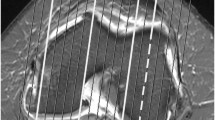Abstract
Objective. To evaluate the frequency and location and to determine the long-term MR changes in patients with edema-like bone marrow abnormalities after acute knee trauma.
Design and patients. A cohort of 176 consecutive patients in a 29 month period with acute injury of the knee joint was examined with MRI. Forty-nine patients with bone marrow edema-like signal alteration on the initial MR examination were re-evaluated with MRI after a minimum of 2 years (mean 44 months). Signal alterations and contour abnormalities on the initial and follow-up MR examinations were classified. The volume of the edema was also measured.
Results. There was a prevalence of post-traumatic edema-like signal changes of 72% in 176 patients. In the follow-up group (n=49) the initial MR examination showed 80 areas of signal change with a mean volume of 15.5 cm3 (range 0.25–175 cm3). Thirty-five (44%) were signal changes without other bony or cartilaginous injuries, 19 (24%) were subchondral impaction fractures and 26 (33%) were osteochondral or chondral fractures. Sixty-nine percent of the lesions were located in the lateral, and 29% in the medial joint compartment. Three percent were patellar lesions. In seven of the 49 patients (14%) eight signal changes were seen on the follow-up MR examination. Six lesions were located in the same anatomic area as on the initial MR examination, and two new lesions had developed. The volume of the bone marrow edema was smaller in all persisting lesions (mean volume 2.26 cm3, range 0.3–4.8 cm3). Deterioration of the subchondral impaction, chondral/osteochondral fracture or lesions resembling osteonecrosis were not found in any patient.
Conclusions. The majority of acute post-traumatic marrow signal changes are found in the lateral compartment and do not show additional osseous or chondral alterations. After a minimum of 2 years acute post-traumatic bone marrow edema-like signal alterations vanish in the majority of patients. Even more severe articular surface injuries such as subchondral bone impaction or chondral/osteochondral fractures will heal without obvious osseous long-term sequelae. Post-traumatic osteonecrosis, as reported in the literature, must be a rare event after acute knee trauma.
Similar content being viewed by others
Author information
Authors and Affiliations
Additional information
Electronic Publication
Rights and permissions
About this article
Cite this article
Roemer, .F., Bohndorf, .K. Long-term osseous sequelae after acute trauma of the knee joint evaluated by MRI. Skeletal Radiol 31, 615–623 (2002). https://doi.org/10.1007/s00256-002-0575-z
Received:
Revised:
Accepted:
Issue Date:
DOI: https://doi.org/10.1007/s00256-002-0575-z




